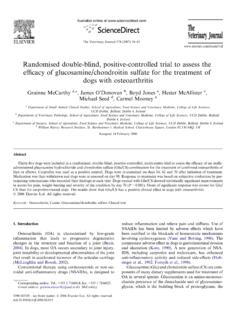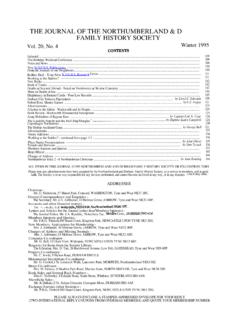Transcription of Modern Manufacturing Processes: A Review - …
1 AbstractNecessity to use new materials, demanding functional requirements and miniaturization have led to evolution of modernmanufacturing processes . Developments are taking place both in the conventional methods and unconventional methods ofmanufacture. High speed machining, hard machining, non conventional processes like beam, mechanical and chemicalprocesses and additive processes like rapid prototyping are some of the Modern Manufacturing processes . This paper aims togive overview of Modern Manufacturing processes that are currently under use/research in the Manufacturing words:High Speed Machining, Machining, Grinding, Micro Electro Chemical Machining, Forming, Turning, SinteringModern Manufacturing processes : A ReviewVelayudham AScientist 'E', Combat Vehicles Research and Development Establishment,Avadi, Chennai, India30 Journal on Design and Manufacturing Technologies, , , November 2007I.
2 INTRODUCTIONC urrently, Manufacturing companies have tocompete in a more and more global market. This globalcompetition has resulted in the development of newmaterials, processes and products. The most importantaspect of these is the advanced design and manufacturingconcepts involved in their production. The necessity to usenewer materials for different applications and control oftheir dimensional accuracies has led to evolution ofmodern Manufacturing methods or processes . This paperreviews some of the Modern Manufacturing methodswhich are used currently / under research and theirapplications.
3 This would help in deciding whether theseprocesses are a viable alternative to what are currentlyunder Manufacturing PROCESSESM anufacturing transforms bulk material into finishedproducts. This process of transformation can be done by putting material together, by moving material from oneregion to another and subtracting unwanted material [1].Advancements are taking place in each of the methods. Ofthe above methods conventional processes are beingfollowed to process the materials that are within somelevel of hardness condition. To process materials withbeyond certain level of workable condition, new processeswith unconventional approach are followed.
4 Theadvancements in each of these will be discussed one Advances in Conventional Machining ProcessesHigh Speed MachiningDevelopments in ultra-hard cutting tool materials,together with improved machine tool spindle and drivesystems, have led to the ability to machine at much highercutting speeds than previously possible. High speedmachining (HSM) allows high material removal rates whilemaintaining relatively low feeds. Thus chip loads andcutting forces can be moderately low. This enablescomplex shapes to be economically machined from thesolid, including items with very thin sections.
5 The highspeed machining is defined as being where conventionalcutting speeds of a particular material are exceeded by afactor of 5-10 ( ). Increased machining accuracy,particularly when machining thin webs, etc., due toreduced chip loads, improved surface finish are some ofthe advantages of HSM [2]. A limitation of using HSM forthe more difficult to machine materials can be reduced toollife and hence the overall cost of machining must Cutting Speed Area Depends On Material B. Hard MachiningHard machining is a machining process carried outon "hard" materials (where "hard" is defined as havinghardness greater than 45Rc).
6 The process is intended toreplace or limit traditional grinding operations that areexpensive, environmentally unfriendly, and inflexible. Theusual Manufacturing sequence for a hardened steel shaft,for example, would be rough turning, finish turning, andhardening followed by finish grinding. With thedevelopment of modem hard tool materials (Ceramicsand CBN), an alternative Manufacturing process is turningof the material in its hardened state (hard turning or hardmachining). Due to its increased flexibility, it is acompetitive alternative to finish grinding. Material removalrates are much higher than grinding and thus machiningtimes can be substantially reduced.
7 There is a reduction inthe number of separate machines required withassociated reductions in lost production time from setupsand transfer between workstations [4].II. DUCTILE REGIME MACHININGI mprovements in machining tolerances haveenabled researchers to expose the ductile materialremoval of brittle materials. Under certain controlledconditions, it is possible to machine brittle materials likeceramics using single point diamond tools so that materialis removed by plastic deformation, leaving a crack-freesurface. This process is termed as ductile regimemachining.
8 Ductile regime machining follows from thefact that all materials will deform plastically if the scale ofdeformation is very small [5].A. Peel GrindingPeel grinding is one of the latest techniques used formachining hard materials. It uses a narrow grindingwheel, usually or less in width, to grind a this process is like machining with aconventional lathe, it is a major competitor to hard thin wheel functions like a single point tool under CNCcontrol. Therefore it is simple to change profiles withoutchanging wheels. It is also suited to grind dissimilarmaterials on one platform.
9 Flexibility is one of the mainattractions of peel grinding and another key advantage isthat there are no driver dogs. But to be successful,machine tools should have high static and dynamicstiffness [6].B. Hybrid Approaches In Conventional processes LaserAssisted Machining (lam)Laser assisted machining is a new and innovativeway of machining hard to wear materials, which aredifficult to machine using conventional methods. LAMcombines laser technology with traditional machiningmethods such as a turning and milling. The laser is used as a heat source with beam focused on the unmachinedsection of the workpiece directly in front of the cutting tool[7].
10 The addition of heat softens the surface layer of thematerial, so that ductile deformation rather than brittledeformation occurs during cutting. By focusing a laserbeam on to the surface of the material, it locally heats the material to more than 1,000 C making it softer and moreductile. The soft, red-hot material ( , Ceramic) is thenremoved with a cutting tool made out of ultra-harddiamond-like material called cubic boron Laser Assisted MachiningBut the position and strength of the laser must becontrolled precisely so that it heats only a tiny portion ofmaterial just before it is machined and does not damagethe work surface and Deformation MachiningDeformation machining is a novel hybrid processthat, on one machine, and in one step, combines themachining of thin structures and single point incrementalforming.






